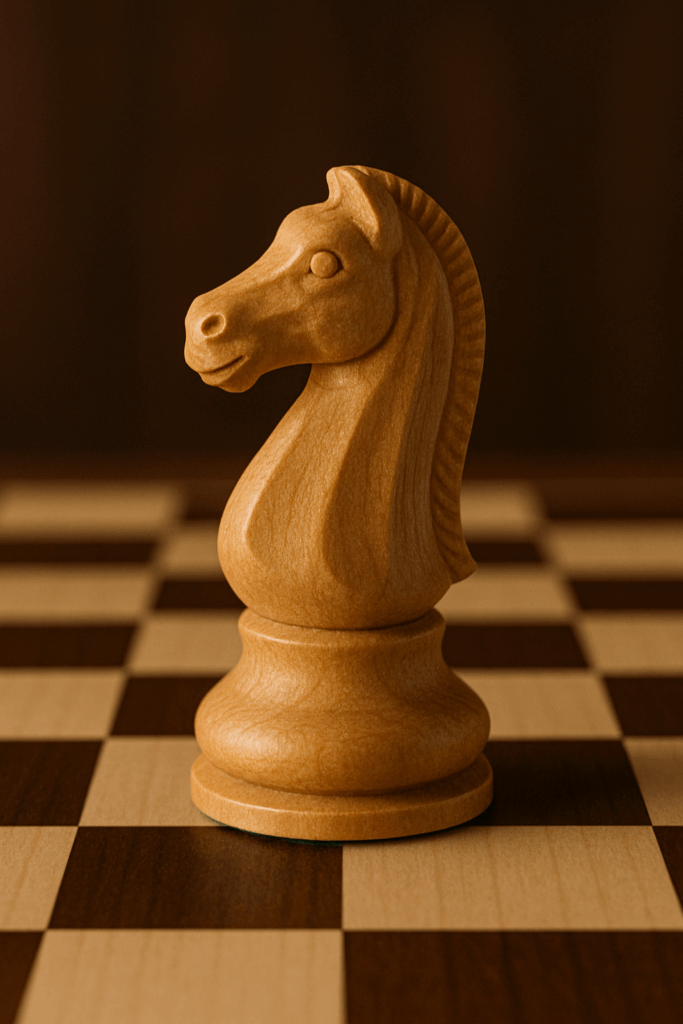Chess Game
Whether you’re a beginner learning the ropes or a parent guiding your child into the world of chess, understanding the types of chess pieces, their moves, and relative value is fundamental.
Each piece in chess serves a unique purpose. Some hold immense power, others are subtle yet strategic. While the King’s safety is paramount, the Queen dominates the board with unmatched versatility. From the disciplined Rook to the tactical Knight, from the quiet Bishops to the humble Pawns every piece is part of a finely tuned system of attack and defense.
But instead of memorizing a dry list, what if we learned their roles through a story?
Let’s step into the Kingdom of Chess, a world where every piece comes alive, each with a mission, a strength, and a tale to tell.
The King – The Soul of the Kingdom (Value: Infinite)

At the heart of the realm stood the King — a slow-moving monarch, one square at a time in any direction. He wasn’t the strongest, nor the fastest, but he was the most important. The fall of the King meant the fall of the kingdom.
Though often shielded behind others, when the time called for courage, the King stepped forward — because in chess, checkmate ends the game, and no treasure could match the King’s worth.
Movement: One square in any direction
Value: Infinite (since losing the King ends the game)
The Queen – The Fierce Commander (Value: 9 Points)

Next to the King stood his most powerful ally — the Queen. A master of both grace and dominance, the Queen could sweep across the board in any direction, covering ranks, files, and diagonals with ease.
She was feared by all, respected by many, and capable of turning tides single-handedly. Her fall could cripple the army, but her presence often spelled doom for the opponent.
Movement: Any number of squares in any direction
Value: 9 points
The Knights – The L-Shaped Warriors (Value: 3 Points)

Galloping across the battlefield were the Knights, the kingdom’s tricksters and tacticians. They moved in an “L” shape — two squares in one direction, then one to the side — leaping over allies and enemies alike.
No wall could block them, and no plan could ignore them. Their value was modest, but in the right hands, a Knight could cause chaos behind enemy lines.
Movement: L-shape (2 + 1), can jump over other pieces
Value: 3 points
The Rooks – The Castle Guardians (Value: 5 Points)

At the kingdom’s corners stood the Rooks, solid towers of strength and stability. They moved in straight lines — horizontally and vertically — with unyielding focus. They often stayed quiet in the early game, but once unleashed, their might was undeniable.
When joined with the King for a special move called castling, they formed a stronghold few could penetrate.
Movement: Any number of squares horizontally or vertically
Value: 5 points
The bishops – The Diagonal Strategists (Value: 3 Points)

By the King and Queen’s side stood the Bishops, wise and swift, gliding diagonally across the board. Each bishop stuck to its path — one to the white squares, the other to black — forever destined to rule only half the realm.
But when they worked together, their synergy created unstoppable attacks and deep strategic pressure.
Movement: Any number of squares diagonally
Value: 3 points
The Pawns – The Unsung Heroes (Value: 1 Point)

And then there were the Pawns — the commoners, the foot soldiers, the front-liners. They moved forward, never backward. One square at a time, except on their first move where they could step twice. They attacked diagonally and often sacrificed themselves for the greater good.
But within their humble spirit lay a secret — promotion. If a pawn reached the other side of the board, it could transform into any piece (usually a Queen). From the lowest to the highest, pawns symbolized potential and perseverance.
Movement: One square forward (two on first move), capture diagonally
Value: 1 point (but with promotion potential)
Summary: Chess Piece Names and Values
| Piece | Value | Movement |
|---|---|---|
| King | ∞ | One square in any direction |
| Queen | 9 | Any direction |
| Rook | 5 | Horizontally or vertically |
| Bishop | 3 | Diagonally |
| Knight | 3 | L-shape (jumps over pieces) |
| Pawn | 1 | Forward, with diagonal capture |
Why Knowing Chess Piece Values is important
Understanding the value of each piece is like knowing the weight of every decision in battle. It helps players evaluate trades, build better strategies, and plan endgames with precision.
But remember value is situational. A pawn that blocks your opponent’s Queen can be more valuable than your Bishop. And a Knight placed in the center can be stronger than a passive Rook.
Master the Pieces, Master the Game
Every chess piece has a role, a value, and a voice in the narrative of the game. From the humble Pawn to the mighty Queen, each one contributes to the symphony of strategy that is chess.
So next time you set up the board, remember you’re not just playing a game. You’re leading a kingdom.






